1993 CHEVROLET CAMARO brakes
[x] Cancel search: brakesPage 67 of 358

I
Ensure the shift lever is fully in P (Park)
range before starting the engine. Your
Chevrolet has a brake-transmission shift
interlock. You have
to fully apply your
regular brakes
before you can shift from
P (Park) when the ignition key is in the
0 R (Reverse)
Use this gear to back up.
11 NOTICE:
I Shifting to K (Reverse) while your
Run position. If you cannot shift out of vehicle is moving forward could
P (Park), ease pressure on the shift lever damage your transmission. Shift to
- push the shift lever all the way into R only after your vehicle is stopped.
P (Park) and also release the shift lever
button on floor shift console models as
you maintain brake application. Then
move the shift lever into the gear you
wish. (Press the shift lever button before
moving
the shift lever on tloor shift
console models.) See "Shifting out of
P (Park)" in this part.
To rock your vehicle back and forth to
damaging your transmission, see "Stuck:
In Sand, Mud, Ice or Snow, If You're"
in the Index.
L get out of snow, ice or sand without
N (Neutral)
In this position, your engine doesn't
connect
with the wheels. To restart when
you're already moving, use
N (Neutral)
only.
Also, use N when your vehicle is
being towed.
639 9
ProCarManuals.com
Page 70 of 358
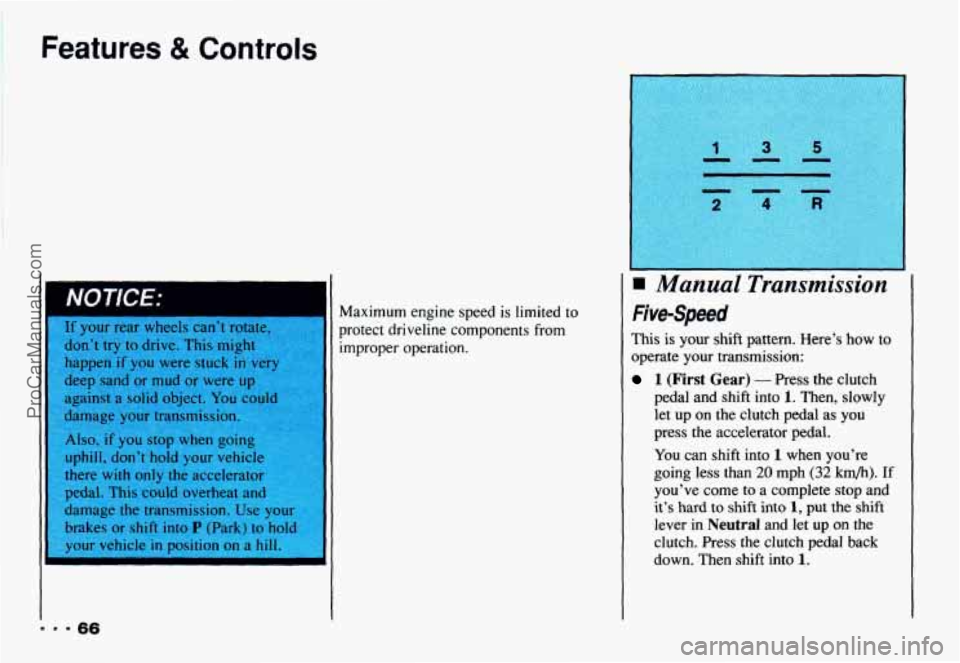
Features & Controls
r
If your rear wheels can’t rotat
don’t try to drive.
This might
happen if you were stuck
in v
deep sand or mud or were up
, , against a solid object. You
damage your transmission
Also, if you stop when goi
uphill, don’t hold your vehi
there
with only the accelerat
pedal. This could overheat an
damage the transmission.
Use your
brakes or shift into
P (Park) to hold
9.966
Maximum engine speed is limited to
protect driveline components from
improper operation.
Manual Transmission
Five-Speed
This is your shift pattern. Here’s how to
operate your transmission:
1 (First Gear) - Press the clutch
pedal and shift into
1. Then, slowly
let up on the clutch pedal as you
press the accelerator pedal.
You can shift into
1 when you’re
going less than
20 mph (32 km/h). If
you’ve come to a complete stop and
it’s hard to shift into
1, put the shift
lever in
Neutral and let up on the
clutch.
Press the clutch pedal back
down. Then shift into
1.
ProCarManuals.com
Page 74 of 358
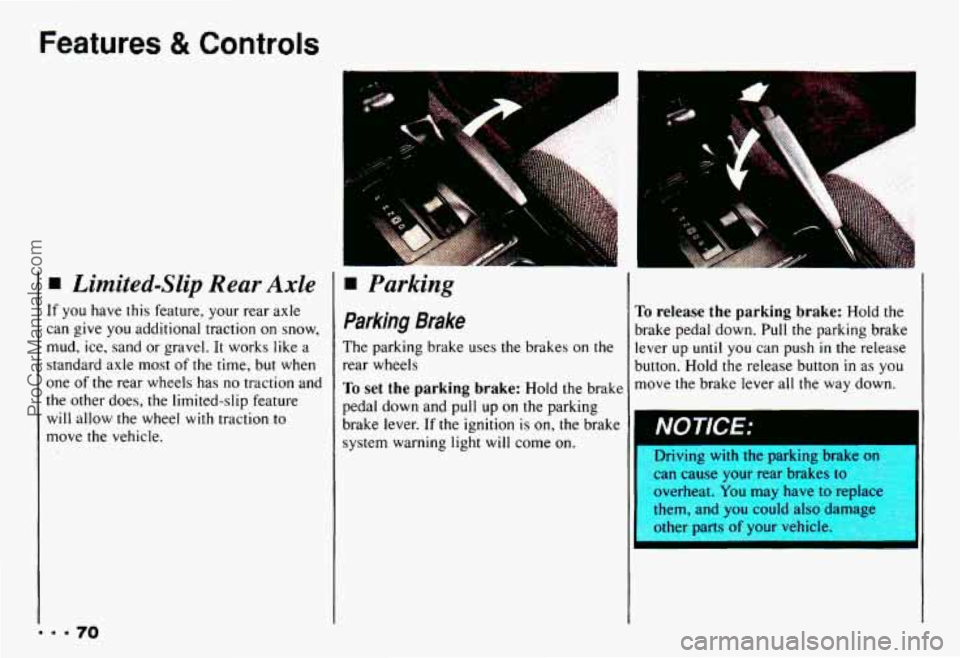
Features & Controls
fl Limited-Slip Rear Axle
If you have this feature, your rear axle
can give
you additional traction on snow,
mud, ice, sand or gravel. It works like a
standard axle most
of the time, but when
one
of the rear wheels has no traction and
the other does, the limited-slip feature
will allow the wheel
with traction to
move the vehicle.
Purking
Parking Brake
The parking brake uses the brakes on the
rear wheels
To set the parking brake: Hold the brake
pedal down and pull up
on the parking
brake lever.
If the ignition is on, the brake
system warning light
will come on.
J
To release the parking brake: Hold the
brake pedal down. Pull the parking brake
lever up
until you can push in the release
button. Hold the release button
in as you
move the brake lever all the way down.
-
on Driving with the parking bra
cause your rear brakes tc
overheat. You may have to replace
them, and you could also
da: ge
sther parts of your vehicl
ProCarManuals.com
Page 84 of 358
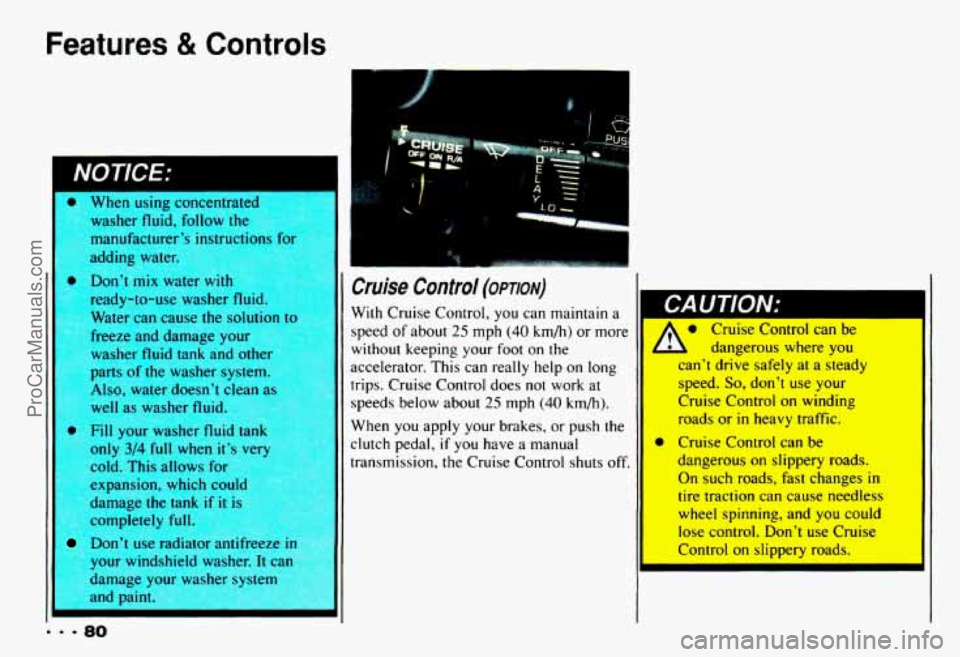
Features & Controls
II
washer fluid, follow the
manufacturer’? instructiopc
fnr
adding water.
Don’t mix warGI with
ready-to-use washer
fluic..
Water can cause the solutinn tn
freeze and damage your
washer
fluid tank and other
parts of the washer systen
Also, water doesn’t clean as
well as washer fluid.
Fill your washer fluid tank
only
3/4 full when it’s ver
cold. This allows
fo
expansion, which COUI(
damage the tank if it is
completely full.
Don’t use radiator anurreeze In
your windshield washer. It can
and paint. damage yolw
wacher cvctpm
-=-8O I
Cruise Control (opmv)
With Cruise Control, you can maintain a
speed of about
25 mph (40 km/h) or more
without keeping your foot on the
accelerator. This can really help on long
trips. Cruise Control does not work
at
speeds below about 25 mph (40 km/h).
When
you apply your brakes, or push the
clutch pedal,
if you have a manual
transmission, the Cruise Control shuts off.
Cruise Control can be
1 L dangerous where you
can’t drive safely at a steady
speed.
So, don’t use your
Cruise Control
on winding
roads or
in heavy traffic.
dangerous
on slippery roads.
On such roads, fast changes in
tire traction can cause needless
wheel spinning, and you
could
lese control. hn’t use Cruise
* Cruise Control can be
ProCarManuals.com
Page 106 of 358

Features 8t Controls
f
I
I
. ’ 102
If the light stays on or comes on when
you’re driving, stop
as soon as possible
and turn the key off. Then start the engine
to reset the system. If the light still stays
on, or comes on again while you’re
driving, your Chevrolet needs service.
Unless the regular brake system warning
light is also on, you
will still have brakes,
but not anti-lock brakes. If the regular
brake system warning
light is also on, see
“Brake System Warning Light” earlier
in
this part. When your anti-lock system is working,
the message
LOW TRAC will appear on
your instrument cluster. This means that
slippery road conditions may exist. Adjust
your driving accordingly. The light
will
stay on for about four seconds after the
ABS stops working. The
LOW TRAC
light also comes on during engine starting
as
a bulb check.
Engine Coolant Temperature Gage
This gage shows the engine coolant
temperature.
If the gage pointer moves
into the red area, your engine is
too hot!
It means that your engine coolant has
overheated. If you have been operating
your vehicle under normal driving
conditions, you should
pull off the road,
stop your vehicle and
turn off the engine
as soon as possible.
HOT COOLANT CAN BURN YOU
BADLY!
In ”Problerns on the Road,” this manual
shows
what to do. See “Engine
Overheating”
in the Index.
ProCarManuals.com
Page 144 of 358

Your Driving and the Road
I
,
I
... 140
There’s something else about drinking
and driving that many people don’t know.
Medical research shows that alcohol
in a
person’s system can make crash injuries
worse. That’s especially true for brain,
spinal cord and heart injuries. That means
that
if anyone who has been drinking -
driver or passenger - is in a crash, the
chance
of being killed or permanently
disabled
is higher than if that person had
not been drinking. And we’ve already
seen that the chance of a crash itself
is
higher for drinking drivers.
IU I I .
urrnKing ana men awing IS
very dangerous. Your reflexes,
perceptions, and judgment
will be
affected by even a small amount of
alcohol. You could have a serious
- or even fatal - accident if you
drive after drinking. Please don’t
drink
and drive or ride with a driver
who has been drinking. Ride home
in a cab; or if you’re with a group,
designate
a driver who will not
drink.
Control of a Vehicle
You have three systems that make your
vehicle
go where you want it lo go. They
are the brakes,
the steering and the
accelerator. All three systems have to do
their work
at the places where the tires
meet the road.
Sometimes, as when you’re driving on
snow or ice, it’s easy to ask more of those
control systems
than the tires and road
can provide. That means you can lose
control
of your vehicle.
ProCarManuals.com
Page 145 of 358
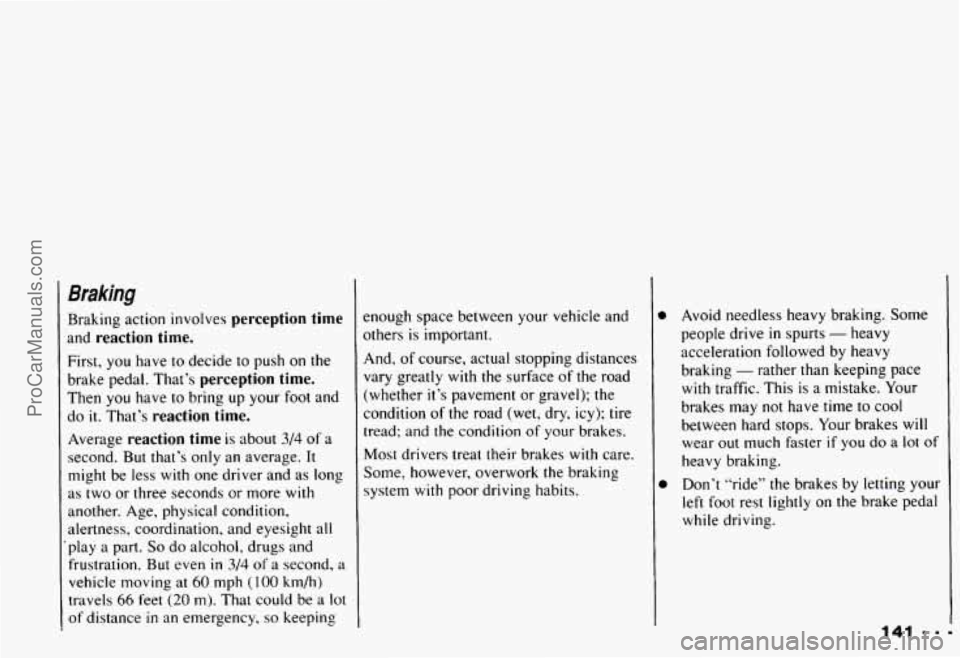
Braking
Braking action involves perception time
and reaction time.
First, you have to decide to push on the
brake pedal. That’s
perception time.
Then you have to bring up your foot and
do
it. That’s reaction time.
Average reaction time is about 3/4 of a
second. But that’s only an average.
It
might be less with one driver and as long
as two or three seconds or more with
another. Age, physical condition,
alertness, coordination, and eyesight all
play a part.
So do alcohol, drugs and
frustration.
But even in 3/4 of a second, a
vehicle moving at
60 mph ( 100 km/h)
travels
66 feet (20 m). That could be a lot
of distance in an emergency, so keeping :nough
space between your vehicle and
Dthers is important.
And, of course, actual stopping distances
vary greatly
with the surface of the road
:whether it’s pavement or gravel); the
;ondition of the road (wet, dry, icy); tire
tread; and the condition
of your brakes.
Most drivers treat their brakes with care,
Some, however, overwork the braking system
with poor driving habits.
B Avoid needless heavy braking. Some
people drive
in spurts - heavy
acceleration followed by heavy
braking
- rather than keeping pace
with traffic. This is a mistake. Your
brakes may not have time
to cool
between hard stops. Your brakes will
wear out much faster
if you do a lot of
heavy braking.
Don’t “ride” the brakes by letting your
left foot rest lightly on the brake pedal
while driving.
ProCarManuals.com
Page 146 of 358
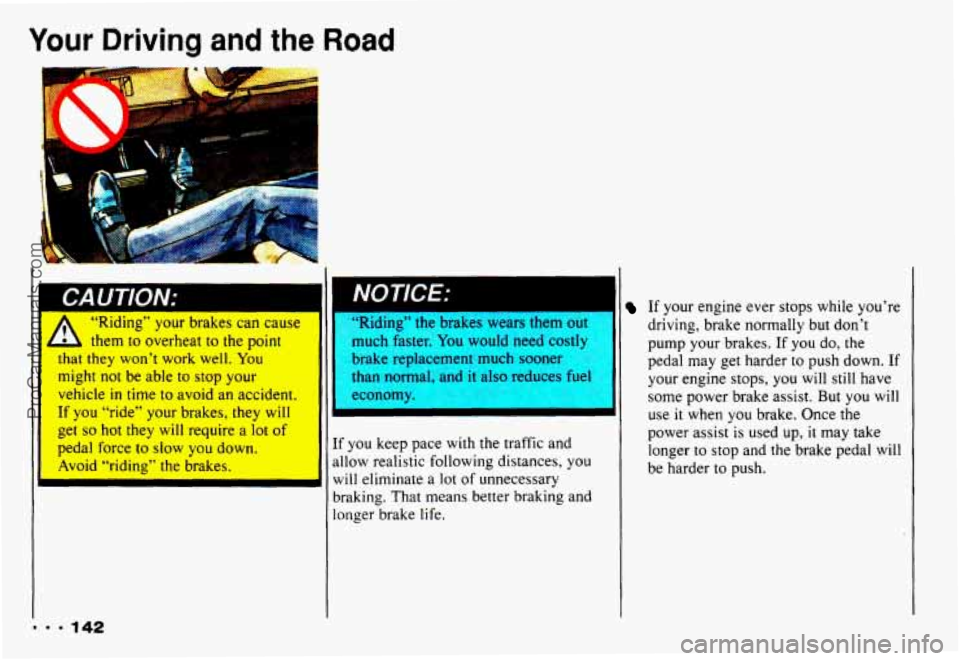
Your Driving and the Road
I
CAUTION: - A 66. nlulllg YVUl UlaKGS Cdn Cause
them to overheat to the point
that they won’t work well. You
might
not be able to stop your
vehicle
in time to avoid an accident.
If you “ride” your brakes, they
will
get so hot they will require a lot of
pedal force to slow you down.
Avoid “riding” the brakes. Klamg-.
me DraaKes wears
tnern 01
lnuch faster. You would need costly
brake replacement much sooner
than normal, and
it also reduces fuel
economy.
If you keep pace
with the traffic and
allow realistic following distances, you
will eliminate a lot of unnecessary
braking. That means better braking and
longer brake life.
I
If your engine ever stops while you’re
driving, brake normally
but don’t
pump your brakes. If you do,
the
pedal may get harder to push down. If
your engine stops, you
will still have
some power brake assist.
But you will
use it when you brake. Once the
power assist is used up, it may take
longer to stop and the brake pedal
will
be harder to push.
ProCarManuals.com